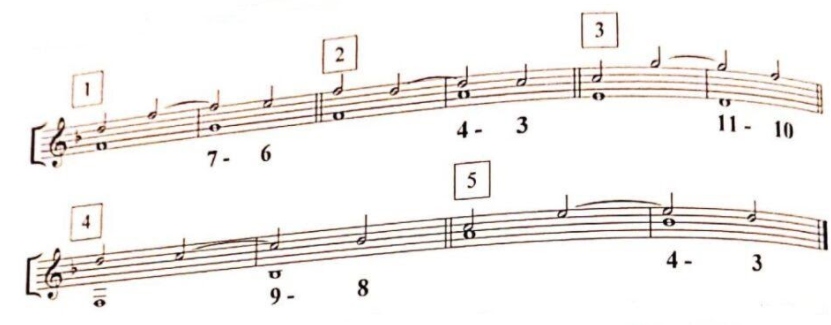Uncategorized
Counterpoint – Fourth Species
https://www.youtube.com/watch?v=aGZ2libMDus
DEFINITION
The fourth species studies the relationship between the counterpoint marching in syncopation against the Cantus Firmus (CF). Thus, harmonic consonances arise in the weak beats, the place from which the syncopation starts.
The prolongation to the strong pulsation of the following beat can be a consonance or dissonance. If it is a consonance, the counterpoint will reach another consonance ascending or descending by downward or upward step, skip or leap.
If the downbeat of the next beat is not consonant, a new ornament emerges the suspension.
This type of syncopation comprises three moments:
PREPARATION
It is the consonant sound to be prolonged against the CF
PROPER SUSPENSION
When it is prolonged, a dissonance is produced against the new note of the CF; it is the suspension itself (since it delays the entry of the consonance on the following beat)
RESOLUTION
The dissonant note resolves. That is, it descends by step progression to a harmonic consonance.
SUMMARIZING
The fourth species’ suspension occurs when, in a succession of beats of even duration, we observe the previous three steps: a note that arises as a consonance, another where the dissonance is generated, and a third that resolves into a consonance again.
The interval nomenclature between the suspension’s dissonant interval and its resolution is written with a hyphen between both intervals, which indicates the direct correspondence between both:
Example of fourth species in Counterpoint:

Contrapuntal Cadences in Fourth Species
Contrapuntal cadences are those cadences in which the suspension is located in the free counterpoint to bring a melody to an end. Thus, a melodic – contrapuntal cadential sense arises:
The CF melodically cadences when it reaches the final note by step progression to the tonic degree:

Cadences in fourth species – C Major example
The counterpoint employs a suspension whose first step is consonant to the 3rd degree of the CF. That consonance is generally the final note that is prolonged when the CF goes to the 2nd degree of the scale in the next beat to resolve in the next degree of the scale and to abandon the syncopation scheme; it concludes together with the CF on the last note in the final sound.
Harmonic Relationships
The characteristics of the harmonic relations resulting in the second and third beats of the suspension are manifested in the following manner:
For example: “suspension of the sixth by the seventh“, that is to say, that the first thing that is indicated in the resolution, which includes the real sound (the consonant resolving interval against the CF).
When the Counterpoint is in the upper voice, these can be:
– 7-6 (suspension of the sixth by the seventh)
– 4-3 (suspension of the third by the fourth)
– 11 – 10 (suspension of the tenth by the eleventh)
– 14 – 13 (suspension of the thirteenth by the fourteenth),
The above relations are preferable since they resolve imperfect consonances, helping the melodic continuity or flow.

“Contrapunto y Polifonia” p.96 (Eduardo Checchi)
Example 5 presents the proper suspension of a tritone (Augmented Fourth) that resolves according to the rule specified above; This is a dynamic interval and, therefore, non-consonant.
The treatment that the tritone receives in this scheme is purely linear. This criterion is the one that prevails over other considerations such as, for example, the harmonic resolutions that this interval category has.
When the counterpoint is found in the lower voice, the relationships are the following:
– 2-3 (suspension of the third by the second)
– 9-10 (suspension of the tenth by the ninth), these are preferable to the following:
– 4-5 (suspension of the fifth by the fourth)
– 11 – 12 (suspension of the twelfth by the eleventh)
– 7-8 (suspension of the octave by the seventh), for the same reasons, explained above.

“Contrapunto y Polifonia” p.96 (Eduardo Checchi)
On the contrary, a sonic relationship between a hard dissonance such as a 9th and a 7th cannot be directed directly to an octave. Both sounds are very far from each other so that the relationship can be perceived in a way similar to a 7th that goes to a 6th. Even the 7th or ninth (major or minors) that resolve in octaves are distant, although at a lower point in sonic quality ratios than the others., that is why the Counterpoint moves from dissonance to an imperfect consonance; moving from a dissonance to a perfect consonance would be to further away from the quality of the initial interval, the dissonance The resolution from dissonance to an imperfect consonance is seen as smoother.
If these relationships occur in musical discourse, several must appear. The discourse is impregnated with these extreme sonorities that are related, thus creating its sound personality throughout that particular discourse.
Beginning of Counterpoint
The beginning of the Counterpoint in the fourth species follows the exact same parameters as the second species, in which the free counterpoint starts with either the octave or perfect fifth when the CF is on the lower voice, and an octave when the CF is on the upper voice.
Parallel Octaves and Fifths
The term “Suspension” means that the consonant harmonic relationship occurs when the prolongation of the syncopation resolves (a sound that in turn may be the beginning of another syncopation).
Hearing also works in this way; when a sound comes syncopated or tied from a previous beat and moves into the next beat, the harmonic relationship is heard in a diagonal sense, a product of the counterpoint movement and the CF. This diagonal listening is paramount to perceive the parallelisms that may occur.
When there is a relationship of 5ths that arise in weak beats, these are understood as parallel 5ths, like the octaves and their compounds. The parallel octaves and fifths produced in this manner are excluded since their sonic characteristics make the voice that produces them lose identity.

“Contrapunto y Polifonia” p.97 (Eduardo Checchi)
It is the case in which the counterpoint relates fifth and sixth. Of the two examples shown above, the first uses the fifths on weak beats. As the hearing is diagonal, they are perceived as parallel 5ths, so this scheme should not be used in continuity.
The second example also uses 5ths and 6ths, where the 6ths are located in the weak beats. Hence, the hearing relates the parallelism between CF and counterpoint as parallelism of 6ths, which can be repeated to the consecutive times explained in the second species’ chapter (no more than three times in a row). We do not consider the second example as Parallel 5ths.
Special Cases
If the discourse of the counterpoint reaches a blind spot, because continuing would produce some error (reaching unison by step progression, creating parallels of octaves, 5ths or their compounds, using the same imperfect interval more than three consecutive times and there is no way to solve or correct these moments, the counterpoint leaves the syncopation for a brief moment, and moves through the second species, in order to relocate to return to the fourth species.
The abandonment of the second species’ syncopation must be very brief and must be found in more than one place in each exercise, like all simple exceptions.

